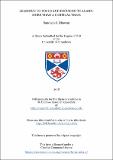Files in this item
Learning to focus and focusing to learn : more than a cortical trick
Item metadata
| dc.contributor.advisor | Brown, Verity Joy | |
| dc.contributor.advisor | Tait, David Scott | |
| dc.contributor.author | Dhawan, Sandeep Sonny | |
| dc.coverage.spatial | 270 p. | en_US |
| dc.date.accessioned | 2018-08-27T13:19:59Z | |
| dc.date.available | 2018-08-27T13:19:59Z | |
| dc.date.issued | 2018-12-06 | |
| dc.identifier.uri | https://hdl.handle.net/10023/15883 | |
| dc.description.abstract | The consequence of many psychiatric and neurodegenerative disorders, such as Parkinson’s disease and schizophrenia, is an impairment in ‘executive functioning’; an umbrella term for several cognitive processes, including the focussing and shifting of attention and the inhibition of responding. The ability to form an ‘attentional set’ involves learning to discriminate qualities of a multidimensional cue, and to subsequently learn which quality is relevant, and therefore predictive of reward. According to recent research, the subthalamic nucleus (STN) and possibly the adjacent zona incerta (ZI) may mediate the formation of attentional set. Dysregulation of the STN as a result of Parkinson’s disease contributes to characteristic motor symptoms, and whilst deep-brain stimulation of this region may treat gross motor impairments, it may also impair cognition. The work in this thesis aimed to expand our understanding of the mechanisms of attentional set-formation, and the role of the STN in this process. This thesis evaluates new methods for examining set-formation in the attentional set-shifting task; rather than inferring this behaviour solely from the cost of shifting set, modifications to the task design in Chapters 3 & 4 explored several hypotheses designed to exploit a deficit in this behaviour. Chapter 6 revealed that inhibition of this region with designer receptors leads to a disruption in attentional selectivity, which compromises the ability to form an attentional set. This manifested as an inability to parse relevant information from irrelevant, and instead, animals learned the stimuli holistically. The findings in this thesis also suggested that reversal and attentional shifting processes do not operate independently, but rather in a hierarchy, and that consequently, the STN is a region that may be crucial in selecting appropriate responses during associative learning that leads to the formation of an attentional set. | en_US |
| dc.language.iso | en | en_US |
| dc.publisher | University of St Andrews | |
| dc.relation | Learning to focus and focusing to learn: more than a cortical trick (Thesis data) Dhawan, S.S. University of St Andrews, DOI: https://dx.doi.org/10.17630/0d90f281-6448-46ae-8b29-1d2d4ca2dbe8 | |
| dc.relation.uri | https://dx.doi.org/10.17630/0d90f281-6448-46ae-8b29-1d2d4ca2dbe8 | |
| dc.rights | Attribution-NonCommercial-NoDerivatives 4.0 International | * |
| dc.rights.uri | http://creativecommons.org/licenses/by-nc-nd/4.0/ | * |
| dc.subject | Cognition | en_US |
| dc.subject | Executive functioning | en_US |
| dc.subject | Behavioural neuroscience | en_US |
| dc.subject | Attention | en_US |
| dc.subject | Set-shifting | en_US |
| dc.subject.lcc | QP405.D5 | |
| dc.subject.lcsh | Cognition | en |
| dc.subject.lcsh | Executive functions (Neuropsychology) | en |
| dc.subject.lcsh | Attention | en |
| dc.subject.lcsh | Set (Psychology) | en |
| dc.subject.lcsh | Subthalamus | en |
| dc.title | Learning to focus and focusing to learn : more than a cortical trick | en_US |
| dc.type | Thesis | en_US |
| dc.contributor.sponsor | University of St Andrews. St Leonard's College Scholarship | en_US |
| dc.type.qualificationlevel | Doctoral | en_US |
| dc.type.qualificationname | PhD Doctor of Philosophy | en_US |
| dc.publisher.institution | The University of St Andrews | en_US |
The following licence files are associated with this item:
This item appears in the following Collection(s)
Except where otherwise noted within the work, this item's licence for re-use is described as Attribution-NonCommercial-NoDerivatives 4.0 International
Items in the St Andrews Research Repository are protected by copyright, with all rights reserved, unless otherwise indicated.


